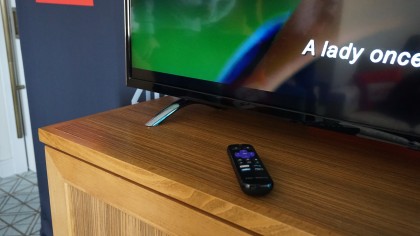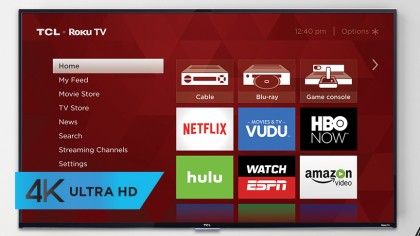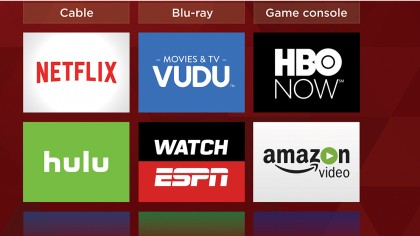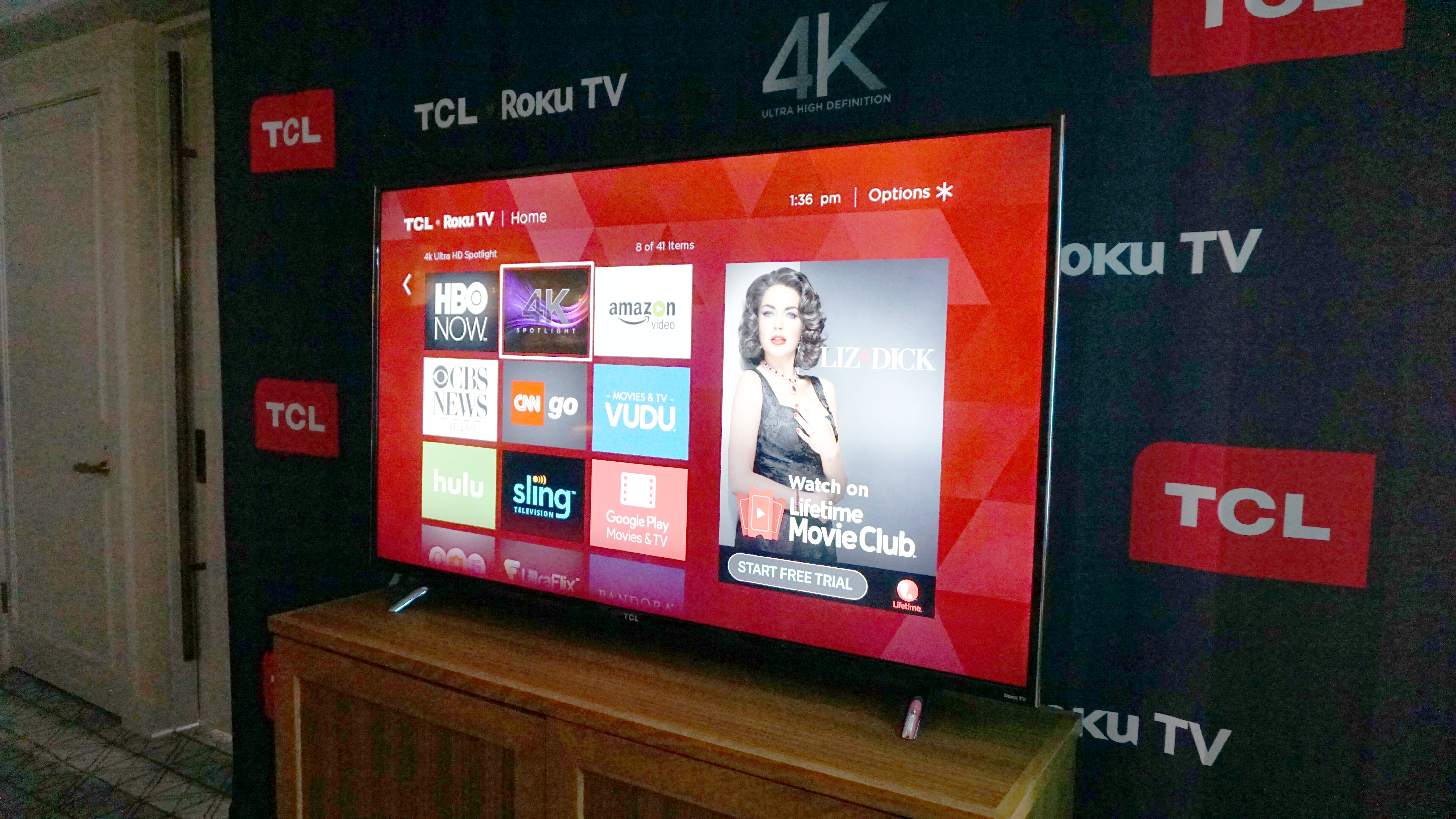Early Verdict
As long as you don't mind missing out on HDR content, TCL's 4K Roku TV eloquently combines the power of Roku's platform and the cost-effectiveness of TCL TVs.
Pros
- +
Over 3,000 Roku channels
- +
Voice search on Roku OS
- +
Insanely low pricing
Cons
- -
No HDR
- -
Screen-casting on Roku is lacking
Why you can trust TechRadar
The original TCL Roku TV was good, but the 4K TCL Roku TV is better. How much better is it, you ask? By my estimate, about 6,220,000 pixels better. Lame jokes aside, TCL's latest sets are actually a natural, impressive evolution for its Roku TV series.
We first heard the pitch for 4K UHD Roku TVs back in January 2015, but it wasn't until CES 2016 – one full year later – that we saw the first shelf-ready models.
Like the first TCL Roku TVs that came out in 2014, the premise of the 4K Roku TVs is a simple one: take the robust content library on Roku and embed it straight into a television, no extra boxes or cables needed.
As the name suggests, TCL's latest panels are able to stream 4K content from apps like Netflix, Amazon Instant Video, Ultra Flix and Vudu, as well as play 4K content from an external source, thanks to its four HDMI 2.0 ports that support HDCP 2.2.
The 4K Roku TV will launch in two series, P and S. The S-Series (the 'S' stands for Smart) comes in a 55 and 65-inch variety and start at $599 for the smaller panel and jump up to $999 for the 65-incher.

The P-Series (the 'P' stands for Premium), on the other hand, starts at $499 for a 43" screen, $599 for a 50", $699 for a 55" and goes up to $1,099 for a 65-incher. If there's one thing you can count on from the Chinese panel manufacturer, it's a good a price.
Chris Larson, VP of sales and marketing at TCL, says that's because, unlike many other TV manufacturers out there, TCL makes most of the components inside the panel.
Sign up for breaking news, reviews, opinion, top tech deals, and more.
Both the S-Series and P-Series use the platform-agnostic Roku OS, both come equipped with the latest 802.11ac wireless antenna and Ethernet port for lag-free streaming, and both will have access to the same firmware updates.
While the two are almost identical on paper, they work slightly differently due to difference in remotes – the S-Series comes with a "dumb" remote, while the P-Series comes with a smart one that's nearly identical the one found on the Roku 4.
So, how was test-driving the first 4K Roku TV to ditch the streaming player? So long as you can live without high-dynamic range (or HDR) content, simply excellent.

Design and image quality
Design-wise, the 4K TCL Roku TV isn't a wild departure from its predecessor, but it does make a few subtle changes that add to the original's sleek design.
The first thing you'll notice after drooling at the 4K image on-screen is the razor-thin, black bezel that encases the image. It's one of the most striking features of the original, and I'm glad to see it make a return on TCL's 2016 line-up.
Like most of the 2015 models – the S3800, S3750, FS3800 and FS3850 – this year's lineup will stand on two sets of legs instead of a traditional pedestal. In theory, this should prevent the TV from potentially tipping over. Though, whether the former or the latter is better looking is up for debate.
Inside the screen, you'll find TCL's Creative Pro 4K UHD up-scaling technology that delivers near-4K quality from 1080p HD sources and 802.11ac, dual band Wi-Fi, a big step up from last year's 802.11n wireless adapter that could only push about 600Mbps.
Should you have the cabling available, however, Larson recommends hardwiring the TV to your network via the newly added ethernet port to decrease buffering time and improve image quality.
Speaking of ports, you can spot four HDMI 2.0 ports on the rear of the panel that support HDCP 2.2, the latest content protection protocol that allows Ultra HD content to pass through hassle-free.

The final new addition, at least on the P-Series, is the enhanced remote that integrates voice search via a built-in microphone and headphone jack similar to the one found on Roku 2, Roku 3, Roku 4 and Roku Streaming Stick remotes for private listening.
I didn't spend as much time as I would've liked perusing my Netflix queue and checking for hot spots produced by the LED backlight. But, from what I did see, the 4K Roku TV produced a solid 4K picture with decent contrast and relatively rich colors.
I'm disappointed that TCL is skipping the opportunity to add HDR support for the 2016 lineup, but Larson told me that TCL would have more to show on that front down the road.
Like the new Vizio SmartCast P-Series TVs that I saw recently, I didn't find the TCL 4K Roku TVs overall picture to be as bright or as vivid as LG's G6 OLED and didn't pop the same way Samsung's SUHD with Quantum Dot did at CES 2016 a few months ago. But, for its price, the picture quality is still darn good.

Roku OS
Even the brightest and most vivid of TVs are worthless without a strong library of content to back them up. Thankfully, when it comes to content, TCL has got Roku on its side.
The Roku TV operating system (OS) looks almost identical to the one found on the streaming boxes, which is a very good thing.
On multiple occasions, I've called Roku the most egalitarian OS on the market, and the same could be said for the version you'll get on TCL's new panels.
It doesn't care whether you pick Netflix over Amazon, or Vudu over Hulu. It doesn't want to sell you an Rdio subscription, and it couldn't care less if you were to join YouTube Red. At the end of the day, all Roku cares about is getting you to the content you want through the most affordable means possible.

It achieves this by implementing a universal search function that scans 30 services like Amazon Instant Video, MGO, Showtime, Netflix and HBO Now for the lowest price.
"And that number keeps going up all the time," Larson said. "If you would've asked me last week, I would've only been able to say that we search 25 channels."
In total, the Roku platform has more than 3,000 channels, including live TV services, like Sling TV, music channels, like Pandora and Spotify and media streaming services, like Plex.
One of the features Larson and his team are most excited about bringing to the 4K lineup is Roku's 4K Spotlight Channel that hosts a curated list of all the movies available to stream in Ultra High-Definition.

In addition to the curated content provided by Roku, the OS allows you to create a curated content list of your own in Roku Feed. It works by searching movies, new or old, and adding them to the list. Then, when they get a price drop or pop on to services like Netflix or HBO, you'll get an alert on your TV and Roku app if you have it installed.
The Roku app, admittedly, is my least favorite aspect of Roku. Screen-casting is still possible through the Play on Roku feature inside the app, but it's nowhere near as accessible as it is on devices like Chromecast or Apple TV.
Early verdict
By adopting Roku's platform and striving to achieve the most accessible prices on the market, TCL has taken every step necessary to compete with LED TV juggernauts Samsung and LG in 2016.
Slight tweaks to this year's sets should improve the already outstanding experience of owning a Roku TV, and I don't think anyone would complain about the addition of 6,220,000 pixels.
That said, it would've been great to see TCL tackle HDR streaming, but perhaps that's something coming sooner rather than later.
The 4K TCL Roku TV 5800 model will be available for pre-order on Amazon starting today, and units will start shipping out March 30 with additional models and retailers to follow.

Nick Pino is Managing Editor, TV and AV for TechRadar's sister site, Tom's Guide. Previously, he was the Senior Editor of Home Entertainment at TechRadar, covering TVs, headphones, speakers, video games, VR and streaming devices. He's also written for GamesRadar+, Official Xbox Magazine, PC Gamer and other outlets over the last decade, and he has a degree in computer science he's not using if anyone wants it.
What is a hands on review?
Hands on reviews' are a journalist's first impressions of a piece of kit based on spending some time with it. It may be just a few moments, or a few hours. The important thing is we have been able to play with it ourselves and can give you some sense of what it's like to use, even if it's only an embryonic view. For more information, see TechRadar's Reviews Guarantee.
